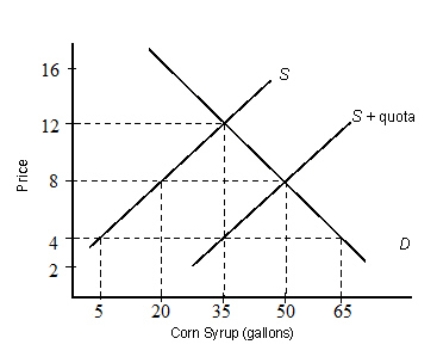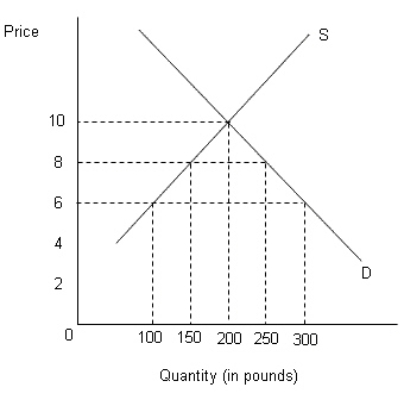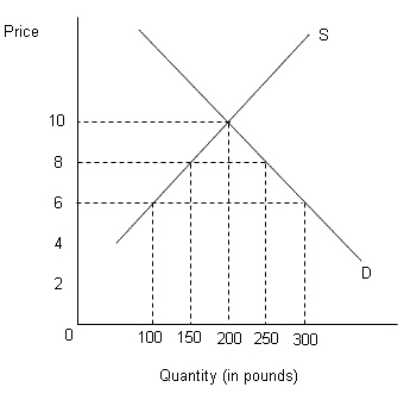A) 450 bushels
B) 350 bushels
C) 200 bushels
D) 150 bushels
E) 300 bushels
Correct Answer

verified
Correct Answer
verified
Multiple Choice
In 1992 the EEC was replaced by the EU with an agreement to:
A) reduce trade barriers among the member countries.
B) reduce trade barriers against nonmember countries.
C) mutually restrict imports from nonmember countries.
D) create a single market for goods and services in western Europe.
E) enable the countries of Western Europe to emerge as major world powers.
Correct Answer

verified
Correct Answer
verified
Multiple Choice
One important unintended consequence of the Smoot-Hawley Tariff Act was to:
A) lessen the severity of the Great Depression by increasing exports.
B) provide the federal government with an effective tool for exercising monetary policy.
C) increase the efficiency of domestic automobile production.
D) increase the severity of the Great Depression by causing other countries to retaliate, and thus leading to a decline in exports.
E) increase the U.S.government budget deficit by $15 million.
Correct Answer

verified
Correct Answer
verified
True/False
In a free trade area, member nations have no trade barriers among themselves but are free to set their own trade policies toward nonmembers.
Correct Answer

verified
Correct Answer
verified
Multiple Choice
Which of the following would result from a tariff?
A) An increase in government budget deficit
B) An increase in domestic production
C) A greater volume of international trade
D) Increased domestic consumption
E) Decrease in prices of the imported goods
Correct Answer

verified
Correct Answer
verified
Multiple Choice
The figure below shows the demand (D) and supply (S) curves of corn syrups. Figure 20.3  In Figure 20.3, with an import quota of 30 gallons of corn syrup, what is the new equilibrium price?
In Figure 20.3, with an import quota of 30 gallons of corn syrup, what is the new equilibrium price?
A) $4
B) $6
C) $8
D) $10
E) $12
Correct Answer

verified
Correct Answer
verified
True/False
If the average costs of production decline with increases in output, then the larger a firm is, the lower its per unit costs will be.
Correct Answer

verified
Correct Answer
verified
Multiple Choice
The figure below shows the demand (D) and supply (S) curves of cocoa in the U.S. Figure 20.4  Refer to Figure 20.4.If cocoa sells for $6 per pound in the world market, determine the volume of U.S.cocoa imports.
Refer to Figure 20.4.If cocoa sells for $6 per pound in the world market, determine the volume of U.S.cocoa imports.
A) 250 pounds
B) 350 pounds
C) 300 pounds
D) 150 pounds
E) 200 pounds
Correct Answer

verified
Correct Answer
verified
True/False
Industries that are truly critical to the national defense should be protected from foreign competition if that is the only way to ensure their existence.
Correct Answer

verified
Correct Answer
verified
Multiple Choice
If international trade is restricted by the government:
A) domestic consumers are benefited.
B) domestic producers are adversely affected.
C) consumers in the importing country are required to pay higher prices for the goods.
D) consumers can access to better quality product at lower prices.
E) the resources are allocated to their highest paid uses.
Correct Answer

verified
Correct Answer
verified
True/False
Tariff accounts for 32% of the total government revenue in the U.K.and only 1.2% in India.
Correct Answer

verified
Correct Answer
verified
Multiple Choice
According to empirical observations, the cost of restricting international trade in the U.S.is much greater than the benefits generated from restriction.In the light of the above observation, which of the following statements is true?
A) The benefits of protecting domestic jobs typically outweigh the costs.
B) Consumers end up paying much more for the goods they buy in order to subsidize the relatively inefficient domestic producer.
C) U.S.GDP would be over $14 billion higher with import restrictions than without restrictions.
D) Protection of the U.S.textile and sugar industries means that all consumers pay a lower price for clothing and sugar.
E) Protection of the domestic industries enable the producers to charge lower prices for their products.
Correct Answer

verified
Correct Answer
verified
True/False
One danger associated with calls for fairness based on reciprocity is that, calls for fair trade may be invoked in cases where, foreign restrictions on U.S.imports do not actually exist.
Correct Answer

verified
Correct Answer
verified
Multiple Choice
Which of the following probably best explains why trade restrictions are imposed even if the costs to consumers are greater than the benefits to protected industries?
A) Indifference on the government's part to the interests of domestic workers
B) A desire to make other countries suffer
C) Successful lobbying by consumers
D) Successful lobbying by employers and workers
E) The government's preference to safeguard the interest of the producers at the expense of the consumers
Correct Answer

verified
Correct Answer
verified
True/False
In order to protect key industries, some countries impose taxes on their exports instead of imports, mainly because it is easier to collect taxes from the export industry.
Correct Answer

verified
Correct Answer
verified
Multiple Choice
A customs union is an organization of nations whose members:
A) have impenetrable trade barriers among themselves but impose no trade barriers on nonmembers.
B) have no trade barriers among themselves but impose common trade barriers on nonmembers.
C) have no trade barriers among themselves but each member country chooses its own trade policies toward nonmember countries.
D) retaliate each other by raising reciprocal tariffs.
E) neither have trade barriers among themselves nor impose any restriction on the nonmember countries.
Correct Answer

verified
Correct Answer
verified
Multiple Choice
The figure below shows the demand (D) and supply (S) curves of cocoa in the U.S. Figure 20.4  According to Figure 20.4, the no-trade equilibrium price and quantity of cocoa in the U.S.market are:
According to Figure 20.4, the no-trade equilibrium price and quantity of cocoa in the U.S.market are:
A) $8 and 150 pounds.
B) $10 and 250 pounds.
C) $4 and 200 pounds.
D) $10 and 200 pounds.
E) $6 and 300 pounds.
Correct Answer

verified
Correct Answer
verified
True/False
The United States has no comparative advantage in shipping, so a domestic shipping industry has no reason to exist.
Correct Answer

verified
Correct Answer
verified
True/False
When production does not proceed on the basis of comparative advantage, resources are expended on their most efficient uses.
Correct Answer

verified
Correct Answer
verified
Multiple Choice
Which of the following statements is true of the impact of trade restrictions on domestic employment?
A) Domestic firms will produce the goods that otherwise would have been produced abroad, thus employing foreign workers instead of domestic workers.
B) Beside the protected industry, other industries will also benefit in terms of employment.
C) Domestic consumers will be required to pay lower prices for the output of the protected industry.
D) Restrictions imposed on trade simply redistribute jobs by creating employment in the protected industry and reducing employment elsewhere.
E) If other countries retaliate by restricting the entry of the domestic exports, the output of domestic firms that produce for export will rise.
Correct Answer

verified
Correct Answer
verified
Showing 21 - 40 of 109
Related Exams